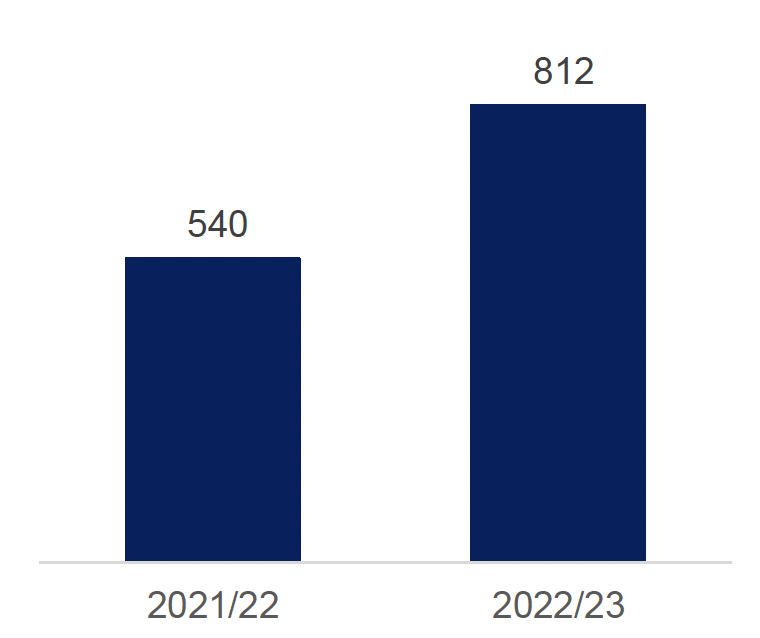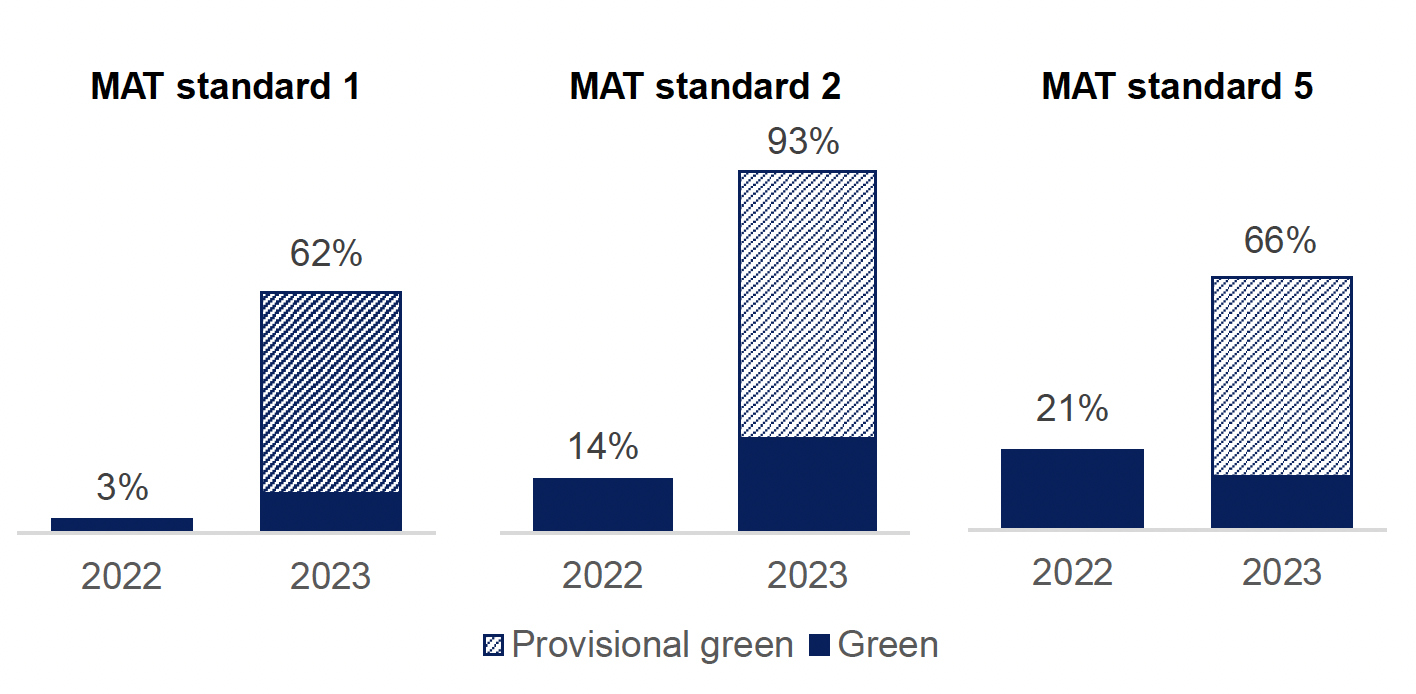National Mission on Drugs: annual monitoring report 2022-2023
Provides an analysis of the progress made against the National Mission on Drugs between April 2022 and March 2023. This is aimed at reducing the number of drug-related deaths and improving the lives of people affected by drugs in Scotland.
8. Outcome 4: People receive high quality treatment and recovery services
8.1 Summary
Outcome 4: People receive high quality treatment and recovery services
7,867 people started specialist treatment who had an initial assessment recorded in 2022/23
- This is a decrease of 12% since 2021/22
29,161 people were prescribed opioid substitution therapy in 2022/23
- There has been little change since the start of the National Mission
There were 812 statutory-funded residential rehabilitation placements approved in 2022/23
- This is an increase of 50% since 2021/22
Overall, the data suggest that standards of care are improving but this has not resulted in an increase in the number of people accessing specialist treatment. Future work to analyse barriers and needs would improve understanding.
8.2 Background
A range of services operate in Scotland to support people with problem substance use in Scotland. This includes access to Medication Assisted Treatment (MAT), often in the form of opioid substitution therapy (OST), as well as access to residential services such as rehabilitation. Targets are in place to increase the number of people prescribed OST to 32,000 by 1 April 2024[42] and increase the number of approved publicly funded residential rehabilitation places to 1,000 by the end of this Parliament.[43]
The evidence base for both MAT and residential rehabilitation treatment for problem substance use are well established.[44],[45] The MAT standards, published in May 2021, are evidence-based standards designed to enable the consistent delivery of safe, accessible, high-quality MAT treatment. The Scottish Government is working with ADPs to fully implement these across all localities.[46]
8.3 Headline metrics
8.3.1 Headline metric: Number of people who have an initial assessment recorded
In 2022/23, 7,867 people starting specialist drug or co-dependency treatment had a complete initial assessment recorded on DAISy.[47] This is a decline of 1,093 (12%) compared to 2021/22 (Figure 12), the first year for which these data are available.
Figure 12: The number of people starting specialist treatment who had an initial assessment on DAISy fell in 2022/23
Number of individuals starting specialist treatment for drug and co-dependency who had a complete initial assessment recorded on DAISy treatment database, 2021/22 to 2022/23

Source: Drug and alcohol information system (DAISy) overview of initial assessments for specialist drug and alcohol treatment 2021/22 and 2022/23, Public Health Scotland, June 2023
The majority of people starting treatment for both co-dependency (79%) and drugs (71%) in 2022/23 were male. This was similar to 2021/22. The median age of people starting treatment was lower for co-dependency (33 years in both 2021/22 and 2022/23) compared to drugs alone (36 years in both 2021/22 and 2022/23). Among those presenting for treatment in 2022/23, the age at which drug use became problematic was similar between the two cohorts – 21 years for co-dependency and 22 years for drugs alone, unchanged from 2021/22.
8.3.2 Headline metric: Number of people prescribed Opioid Substitution Therapy
Opioid Substitution Therapy (OST) was prescribed to an estimated minimum of 29,161 people in Scotland in 2022/23.[48] This is a decrease of 439 people (1%) compared to 2021/22. There has been very little change in the total number of people prescribed OST over the past ten years. However, there has been some change in the mix of types of OST prescribed, with an increased proportion of people prescribed long-acting injectable buprenorphine (Buvidal) in recent years.
8.3.3 Headline metric: Number of approved statutory funded residential rehabilitation placements
There were 812 approved statutory funded placements for residential rehabilitation in 2022/23. This is a substantial increase of 272 placements (50%) compared to 2021/22 (Figure 13).[49]
Figure 13: The number of approved statutory funded residential rehabilitation placements has increased markedly
Number of approved statutory funded residential rehabilitation placements, 2021/22 to 2022/23

Source: Interim monitoring report on statutory funded residential rehabilitation placements: placements approved by Alcohol and Drug Partnerships between 1 April 2021 and 31 March 2023, Public Health Scotland, June 2023
The majority of statutory funded residential rehabilitation places were approved by ADPs (2022/23: 84%, 2021/22: 86%), with the remainder made up of National Mission approved places and Ward 5 Woodland View placements.
However, it should be noted that the residential rehabilitation data only capture placements approved, and do not capture instances when a person does not start their placement nor whether a person’s residential treatment programme is completed as planned.
8.4 Supporting metrics
8.4.1 Supporting metric: Percentage of ADP areas where (a) MAT standard 1, (b) MAT Standard 2, and (c) MAT Standard 5, have been fully implemented
In 2023 (Figure 14):
- MAT standard 1 (same day access): 18 out of 29 ADP areas (62%) had fully implemented MAT standard 1. This is an increase of 17 ADP areas compared to 2022. Of the 18 ADP areas where the standard was reported as fully implemented in 2023, three were assessed as ‘green’ and 15 as ‘provisional green’.[50]
- MAT standard 2 (choice): 27 out of 29 ADP areas (93%) had fully implemented MAT standard 2. This is an increase of 23 ADP areas compared to 2022. Of the 27 ADP areas where the standard was reported as fully implemented in 2023, seven were assessed as ‘green’ and 20 as ‘provisional green’.
- MAT standard 5 (retention): 19 out of 29 ADP areas (66%) had fully implemented MAT standard 5. This was an increase of 13 ADP areas compared to 2022. Of the 19 ADP areas where the standard was reported as fully implemented in 2023, four were assessed as ‘green’ and 15 as ‘provisional green’.
Figure 14: Over the last year, ADPs have made substantial progress with implementation of MAT standards 1, 2 and 5
Percentage of ADP areas where (a) MAT standard 1, (b) MAT standard 2, (c) MAT standard 5, were assessed as fully implemented (green or provisional green), 2022 and 2023

Source: National benchmarking report on implementation of the medication assisted treatment (MAT) standards 2022/23, Public Health Scotland, June 2023
The proportion of ADPs assessed as ‘green’ decreased between 2022 and 2023 for some MAT standards. This is explained by a change in methodology (stricter criteria in 2023 than 2022) and the introduction of the ‘provisional green’ category.
8.4.2 Supporting metric: Percentage of ADP areas where MAT standards 6-10 have been fully implemented
No ADP area had fully implemented any of the MAT standards 6-10 in 2023.[51] Numerical evidence was available for two of the three evidence streams – process and experiential. None of the MAT standards 6-10 could be assessed as ‘fully implemented’ as full data covering all evidence steams were not available. There was evidence of partial implementation[52] of these standards across numerous ADP areas in 2023, and future efforts will focus on building sustainable numerical data systems to monitor and improve the implementation of the MAT standards.
8.5 Discussion
Overall, the data suggest that standards of care are improving but this has not resulted in an increase in the number of people accessing specialist treatment. Future work to analyse barriers and needs would improve understanding.
The number of people who have a complete initial assessment recorded on DAISy (a measure of the number of people engaging in specialist treatment) has fallen. However, this may be affected by data completeness issues – compliance with the process to record data on initial assessments in DAISy for all eligible episodes of care varies by area.[53] The total number of people prescribed OST has remained static for several years but there has been an increase in the prescribing of long-acting injectable buprenorphine (Buvidal). Finally, there has been a notable increase in the number of approved statutory funded residential rehabilitation placements in Scotland.
There has been substantial progress made in the national implementation of the MAT standards. However, there is substantial variation in where, how, and to what extent the individual standards are implemented. Numerical data collected for the MAT standards 6-10 will be particularly crucial in determining to what extent they have been fully implemented at the ADP level. Future efforts will focus on meeting the April 2025 target to fully implement MAT standards 1 to 10 in community and justice settings, recognising the need to broaden the standards to include support for all types of substances and treatment.
Overall, this suggests that standards of care are improving for individuals, however this has not resulted in an increase in numbers entering specialist treatment (although there may be a lag between improvements in treatment quality and people engaging with these services and entering treatment). There are limitations to interpreting or drawing conclusions from some of the data (e.g. completeness, shifts in prescribing, outcomes for referrals to residential treatment), but these do not fully account for the overall trends. Future data development to facilitate analysis of current barriers to entering treatment and the specific needs of this population would improve understanding of the progress towards this outcome.
Contact
There is a problem
Thanks for your feedback